The Intel Xeon W-3175X Review: 28 Unlocked Cores, $2999
by Ian Cutress on January 30, 2019 9:00 AM ESTCPU Performance: Encoding Tests
With the rise of streaming, vlogs, and video content as a whole, encoding and transcoding tests are becoming ever more important. Not only are more home users and gamers needing to convert video files into something more manageable, for streaming or archival purposes, but the servers that manage the output also manage around data and log files with compression and decompression. Our encoding tasks are focused around these important scenarios, with input from the community for the best implementation of real-world testing.
All of our benchmark results can also be found in our benchmark engine, Bench.
For our graphs, some of them have two values: a regular value in orange, and one in red called 'Intel Spec'. ASUS offers the option to 'open up' the power and current limits of the chip, so the CPU is still running at the same frequency but is not throttled. Despite Intel saying that they recommend 'Intel Spec', the system they sent to us to test was actually set up with the power limits opened up, and the results they provided for us to compare to internally also correlated with that setting. As a result, we're providing both sets results for our CPU tests.
Handbrake 1.1.0: Streaming and Archival Video Transcoding
A popular open source tool, Handbrake is the anything-to-anything video conversion software that a number of people use as a reference point. The danger is always on version numbers and optimization, for example the latest versions of the software can take advantage of AVX-512 and OpenCL to accelerate certain types of transcoding and algorithms. The version we use here is a pure CPU play, with common transcoding variations.
We have split Handbrake up into several tests, using a Logitech C920 1080p60 native webcam recording (essentially a streamer recording), and convert them into two types of streaming formats and one for archival. The output settings used are:
- 720p60 at 6000 kbps constant bit rate, fast setting, high profile
- 1080p60 at 3500 kbps constant bit rate, faster setting, main profile
- 1080p60 HEVC at 3500 kbps variable bit rate, fast setting, main profile
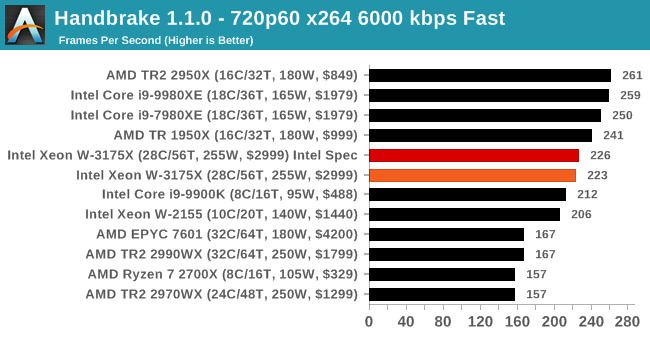
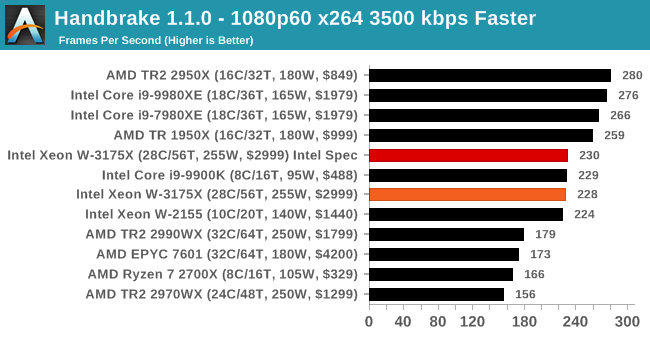
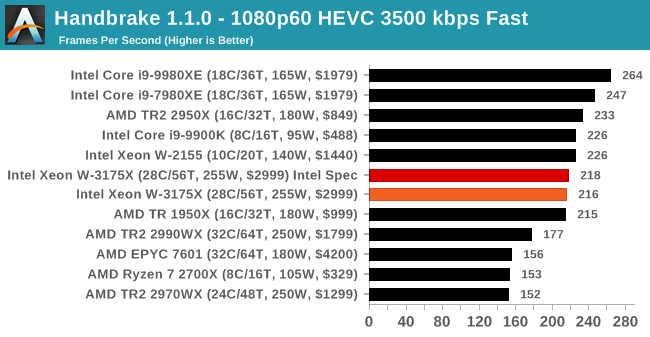
.
7-zip v1805: Popular Open-Source Encoding Engine
Out of our compression/decompression tool tests, 7-zip is the most requested and comes with a built-in benchmark. For our test suite, we’ve pulled the latest version of the software and we run the benchmark from the command line, reporting the compression, decompression, and a combined score.
It is noted in this benchmark that the latest multi-die processors have very bi-modal performance between compression and decompression, performing well in one and badly in the other. There are also discussions around how the Windows Scheduler is implementing every thread. As we get more results, it will be interesting to see how this plays out.
Please note, if you plan to share out the Compression graph, please include the Decompression one. Otherwise you’re only presenting half a picture.
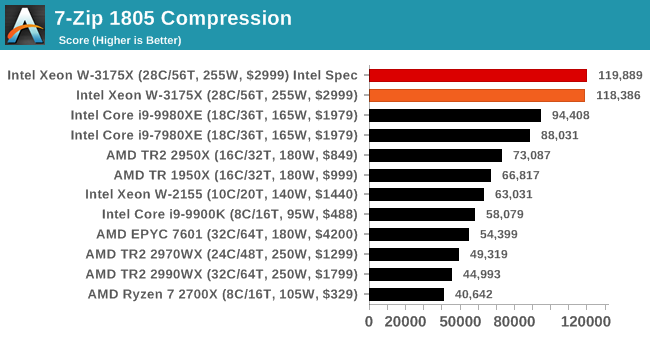
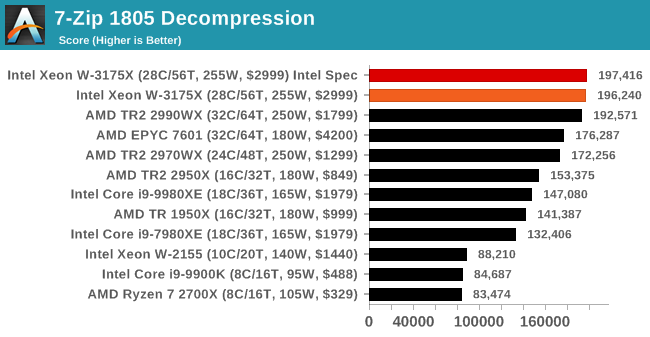
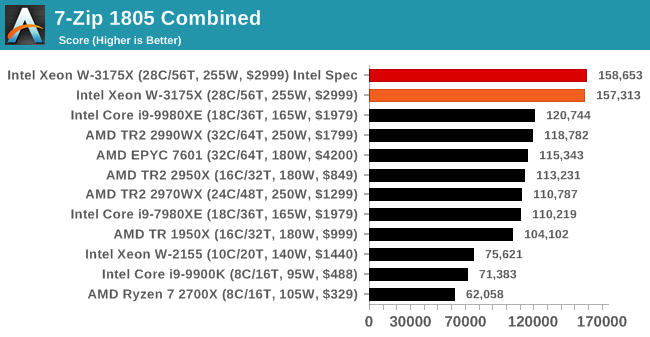
.
WinRAR 5.60b3: Archiving Tool
My compression tool of choice is often WinRAR, having been one of the first tools a number of my generation used over two decades ago. The interface has not changed much, although the integration with Windows right click commands is always a plus. It has no in-built test, so we run a compression over a set directory containing over thirty 60-second video files and 2000 small web-based files at a normal compression rate.
WinRAR is variable threaded but also susceptible to caching, so in our test we run it 10 times and take the average of the last five, leaving the test purely for raw CPU compute performance.
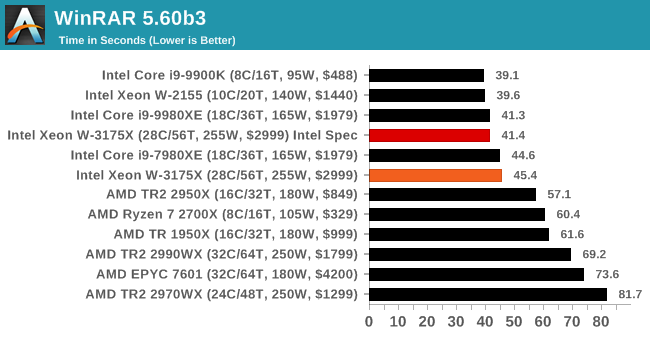
.
AES Encryption: File Security
A number of platforms, particularly mobile devices, are now offering encryption by default with file systems in order to protect the contents. Windows based devices have these options as well, often applied by BitLocker or third-party software. In our AES encryption test, we used the discontinued TrueCrypt for its built-in benchmark, which tests several encryption algorithms directly in memory.
The data we take for this test is the combined AES encrypt/decrypt performance, measured in gigabytes per second. The software does use AES commands for processors that offer hardware selection, however not AVX-512.
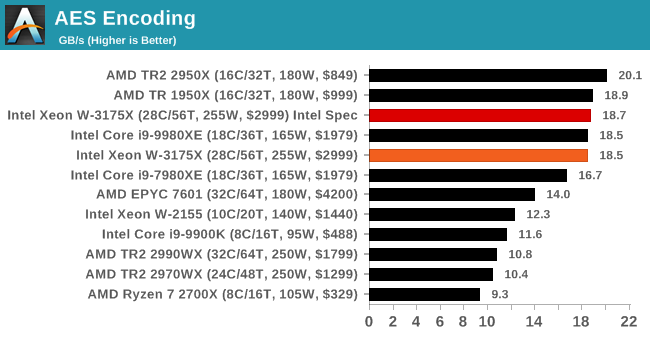
.










136 Comments
View All Comments
johngardner58 - Monday, February 24, 2020 - link
Again it depends on the need. If you need speed, there is no alternative. You can't get it by just running blades because not everything can be broken apart into independent parallel processes. Our company once ran an analysis that took a very long time. When time is money this is the only thing that will fill the bill for certain workloads. Having shared high speed resources (memory and cache) make the difference. That is why 255 Raspberry PIs clustered will not outperform most home desktops unless they are doing highly independent parallel processes. Actually the MIPS per watt on such a processor is probably lower than having individual processors because of the combined inefficiencies of duplicate support circuitry.SanX - Friday, February 1, 2019 - link
Every second home has few running space heaters 1500W at winter timejohngardner58 - Monday, February 24, 2020 - link
Server side: depends on workload, usually yes a bladed or multiprocessor setup is usually better for massively parallel (independent) tasks, but cores can talk to each other much much much faster than blades, as they share caches, memory. So for less parallel work loads (single process multiple threads: e.g. rendering, numerics & analytics) this can provide far more performance and reduced costs. Probably the best example of the need for core count is GPU based processing. Intel also had specialized high core count XEON based accelerator cards with 96 cores at one point. There is a need even if limited.Samus - Thursday, January 31, 2019 - link
The problem is in the vast majority of the applications an $1800 CPU from AMD running on a $300 motherboard (that's an overall platform savings of $2400!) the AMD CPU either matches or beats the Intel Xeon. You have to cherry-pick the benchmarks Intel leads in, and yes, it leads by a healthy margin, but they basically come down to 7-zip, random rendering tasks, and Corona.Disaster strikes when you consider there is ZERO headroom for overclocking the Intel Xeon, where the AMD Threadripper has some headroom to probably narrow the gap on these few and far between defeats.
I love Intel but wow what the hell has been going on over there lately...
Jimbo2K7 - Wednesday, January 30, 2019 - link
Baby's on fire? Better throw her in the water!Love the Eno reference!
repoman27 - Wednesday, January 30, 2019 - link
Nah, I figure Ian for more of a Die Antwoord fan. Intel’s gone zef style to compete with AMD’s Zen style.Ian Cutress - Wednesday, January 30, 2019 - link
^ repoman gets it. I actually listen mostly to melodic/death metal and industrial. Something fast paced to help overclock my brainWasHopingForAnHonestReview - Wednesday, January 30, 2019 - link
My manIGTrading - Wednesday, January 30, 2019 - link
Was testing done with mediation regarding the specific windows BUG that affects AMD's CPUs with more than 16 cores? Or was it done with no attempt to ensure normal processing conditions for ThreadRipper, despite the known bug?eva02langley - Thursday, January 31, 2019 - link
Insomnium, Kalmah, Hypocrisy, Dark Tranquility, Ne Obliviscaris...By the way, Saor and Rotting Christ are releasing their albums in two weeks.
You might want to check out Carpenter Brut - Leether Teeths and Rivers of Nihil - Where Owls Know My Name.